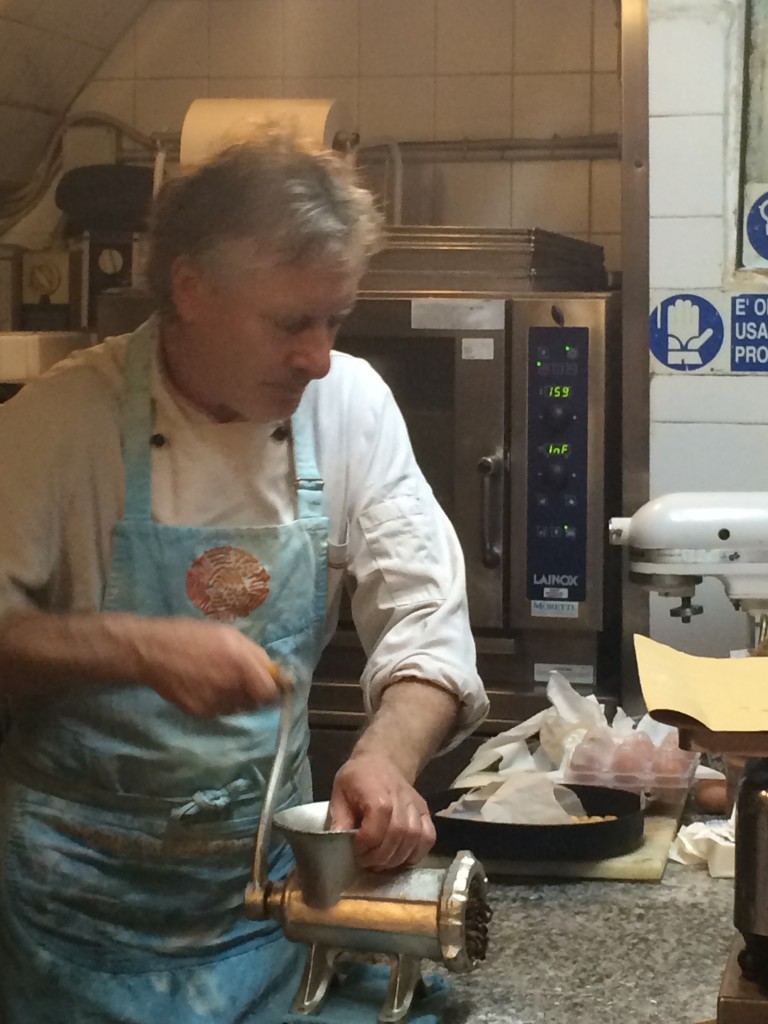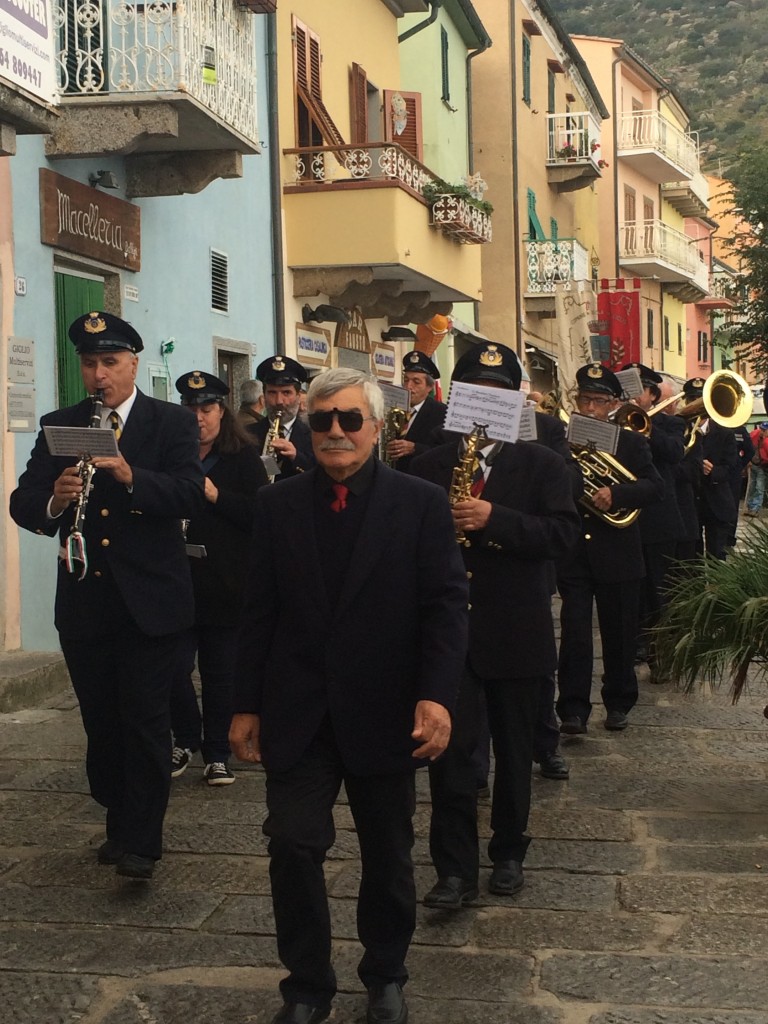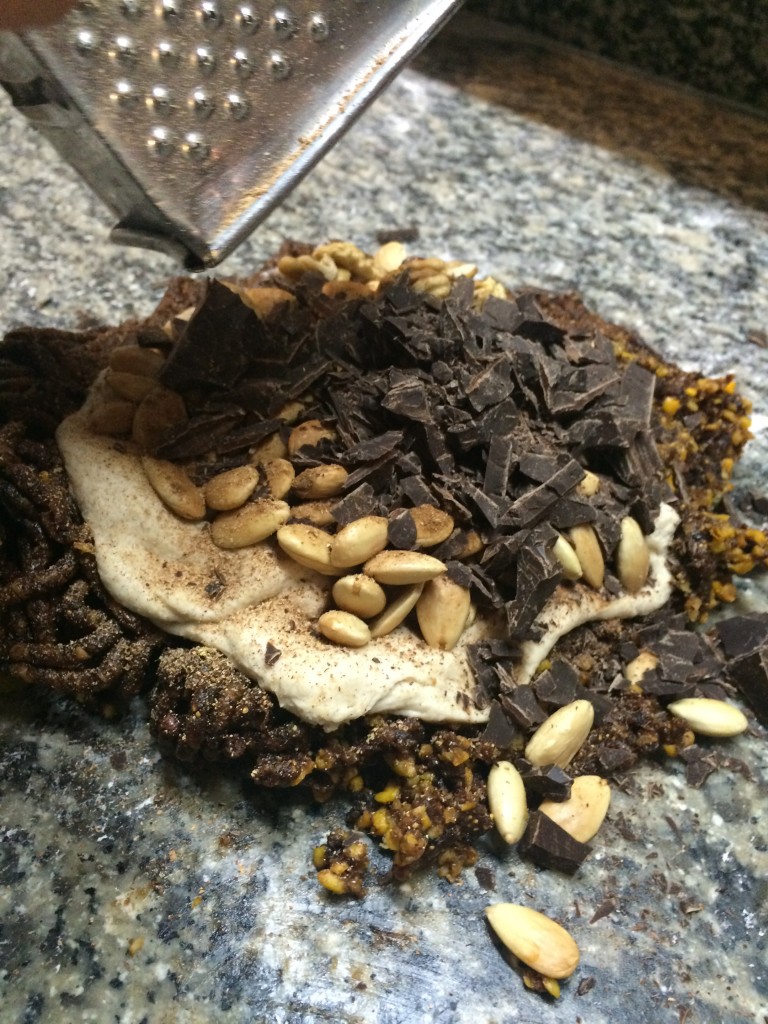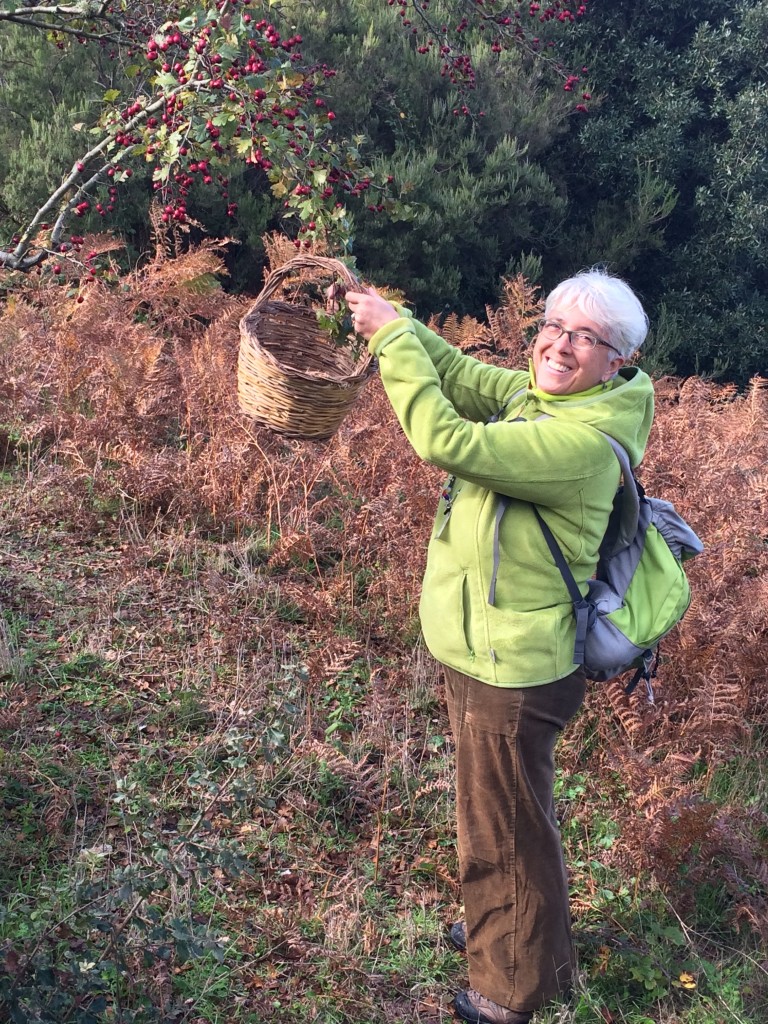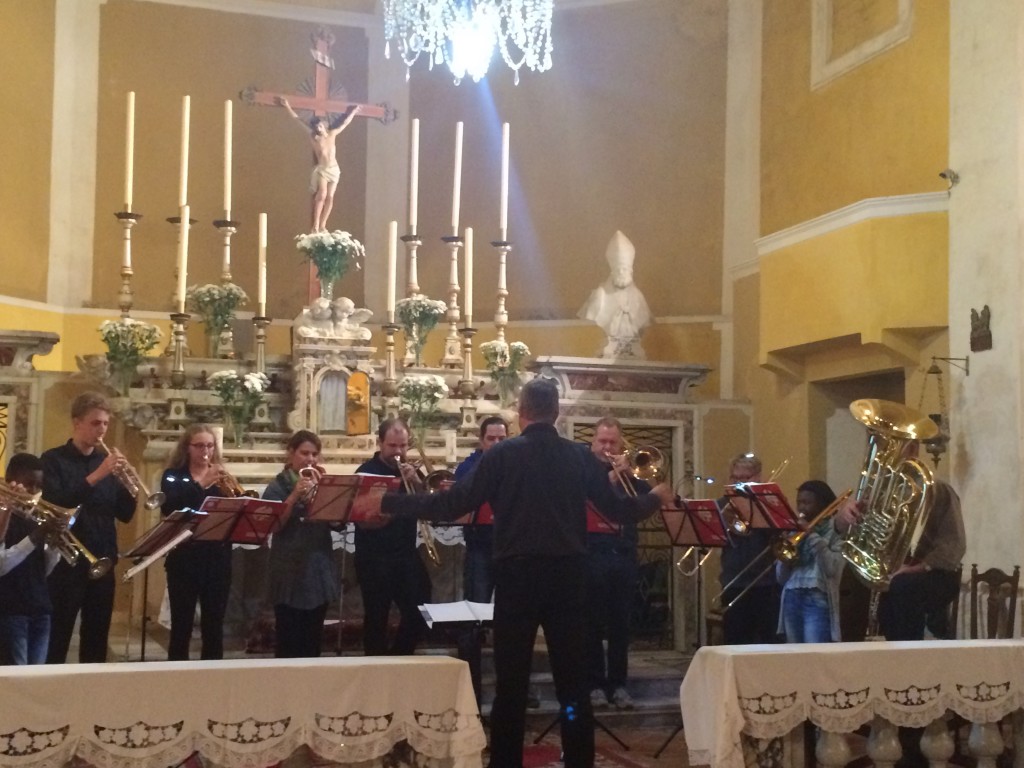Sweet Treats of Giglio
Chef Claudio Bossini had just finished mincing the macerated figs for the panficato, a rich dark sweet Christmas confection made each year on Giglio, a small island off the coast of Tuscany, when suddenly the sounds of a brass band could be heard in the distance.
As I rushed outside to catch a glimpse, the band marched past the restaurant smartly dressed in black uniforms, loudly blowing their trumpets, horns and cornets.
Back in the kitchen, Claudio was busy kneading spices, nuts, dark chocolate, peach jam, bread dough and cocoa into the fig paste.
“It’s just like Christmas,” said Claudio, tilting his head toward the sounds of the band.
It smelt like Christmas too as he added another heaped teaspoon of cinnamon to the mix, grated over more nutmeg and threw in extra roughly chopped dark chocolate.
“It needs more strength,” he commented.
Claudio was showing a group of us from UNISG how to make this traditional cake at La Paloma, his rustic restaurant which faces the sleepy port of Giglio.
While many tourists visit Giglio hoping to see the last remnants of the wrecked Costa Concordia which capsized near the port three years ago, few have heard of panifcato (see recipe below) or two other confections made with ingredients grown on the island: shciaccia di uva secco (sultanas, apples, pears, orange rind, nuts, spices, bread dough, jam, chocolate and cocoa, decorated with pine nuts and sugar) and schiaccia di patate (made on a base of mashed potatoes, flour and salt, topped with macerated sultanas and pine nuts, drizzled with olive oil, pressed down and scattered with sugar and pine nuts).
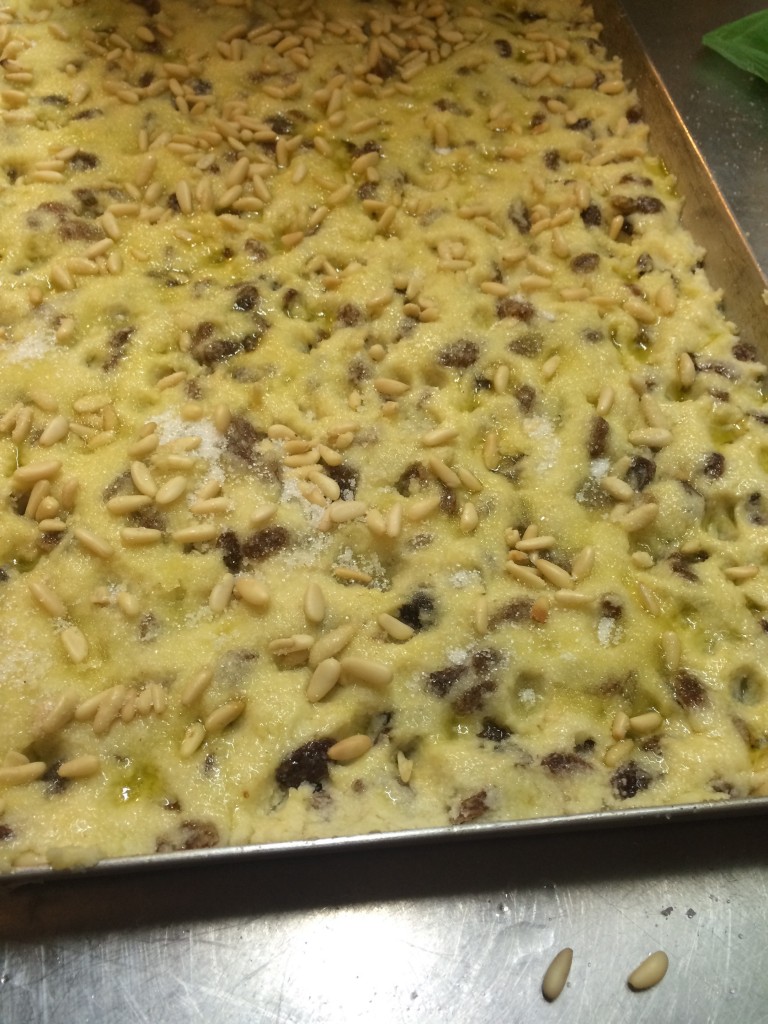 Nor are they aware of Claudio’s cucina spontanea – his spontaneous, imaginative way of preparing the seafood from around the island.
Due to constant fear of pirate raids, fishing was not common until the 19th century when the port was built, and even then the fishermen clung to the coastal waters gathering molluscs and sea urchins.
“In the past, people didn’t have much and had to use what was available,” he told us.
Most of the island is composed of granite and covered in Mediterranean scrub. Figs grew here before the Romans arrived and much of it was once terraced with vines from which the legendary wine of Giglio was made and which formed the basis of the local economy. Legumes have been found in amongst the vines.
“There are 5 – 7 varieties of figs on Giglio, some which fruit in spring and are full of water and good with cheese. Others (neruccioli) fruit in autumn and are small, dark and rich in sugar and can be dried.
“They saved people from starvation in the past. Farmers up around the castle would collect figs during the day and eat them with bread for lunch. “
There are no eggs in these sweets and apricot kernels were often used instead of almonds. The jam was made with the last fruit of autumn, usually pesche sanguine
(late peaches) because they didn’t have enough sugar to preserve it for long.
Panficato was originally made by locals at the castle as most people didn’t have their own ovens. Every step was a shared activity, from soaking the figs in vinella, a legendary wine mentioned by the Roman poet Virgil and used by Popes, to making the bread dough and jam.
“It was a spiritual experience because they put their hands and energy into it,” said Claudio. “Today people add chocolate and cocoa for a richer version. Some even add nutella!”, he added with a frown.
If panficato reminds you of panforte, the famous Siennese speciality made with candied fruits, honey and flour, that’s because the island was repopulated with people from Siena after 700 inhabitants were massacred by Saracen pirates, led by Barbarossa, in 1544.
Today, the Cooperative Greppe Giglio society up near the castle also makes a variety of marmalades and jams with fruit which grows on the island, including a peach and two types of fig jam. They also sell a delicious honey which comes from beehives on the island and make Ansonaco wine, brandy and grappa. Greppe refer to the terraces on the island which stretch from the top of the island down to the sea where vines and other crops have been grown since Roman times. The Coop was set up nine years ago with the aim of getting young people involved in the revival of agriculture on the island.
Our visit to the island included foraging with local environmentalist Marina Aldi who told us that a liqueur is made from the mirto berry which grows wild on the island. They also dry the sprouts, grind them and use them as a herb in cooking. Due to the sun and salty winds, the native plants develop essential oils to survive and many are used for medicinal purposes. Finocchio, chicory and lattatiola (a wild herb which looks like rocket and is a perfect match with tuna) are just some of the other edible wild plants.
I was very impressed with the creativity and industriousness of the people we met in our three days on this little jewel of an island.
One night we were invited up to the castle to a concert. It turned out to be another brass band, only this time the musicians were from Germany. They come each year to study the biology of the island and hold an annual concert to thank the local people for allowing them to study there.
The last tune they played was Auld Lang Syne (“Should old acquaintance be forgot…”) and the woman sitting next to me grabbed my hand, smiled at me and encouraged me to sing along. She had tears in her eyes.
Note: here are a couple of recipes, if you’re interested to try them out:
Panficato
Wrap the individual pieces in cellophane and tie with a bow for a lovely homemade Christmas gift.
1.4kg dried figs, stems removed
medium dry white wine
rind of 2 oranges
200g toasted blanched almonds, roughly chopped
150g bread (or focaccia) dough
70g walnuts, roughly chopped
1 – 2 teaspoons cinnamon (or to taste)
1/4 teaspoon freshly grated nutmeg (or more to taste)
100g – 150g good quality chocolate
1/2 cup jam (preferably peach)
2 tablespoons cocoa
Place the figs in a medium bowl and sprinkle with wine. Cover the bowl and leave for a few hours or overnight to soften.
Preheat oven to 130degC. Line a tray with baking paper.
Mince the figs and orange peel in a mincer, or place in a food processor or thermomix and whizz until a paste is formed.
Remove from food processor and knead in the bread dough, nuts, spices, chocolate, jam and cocoa by hand. If mixture is too wet, add more cocoa. Taste the paste and add more spices, jam or chocolate to taste.
Wet your hands and roll the dough into balls, each weighing about 300g.Place the balls on the baking tray and decorate tops with toasted almonds, walnuts and chocolate.
Bake 30 – 40 minutes. Turn heat up to 180degC and bake a further 10 minutes. Remove from oven and leave to cool before wrapping in cellophane (for Christmas gifts) or store in an airtight container.
Schiaccia di Patate
This rustic Christmas sweetmeat is made at Castello Giglio from ingredients (such as dried grapes, potatoes and pine nuts) which were available on the island.
250g packet sultanas
medium dry white wine
1kg potatoes, peeled, steamed, mashed and cooled
250g plain flour
1 teaspoon salt, or to taste
100g pine nuts
extra virgin olive oil
caster sugar (to taste)
Place the sultanas in a bowl and sprinkle with wine. Cover and leave for a few hours or overnight to soften.
Preheat oven to 180degC.
In another bowl, combine the mashed potatoes with the flour and salt. Spread the potato mixture over a large baking tray lined with baking paper.
Squeeze out moisture from the sultanas and place them evenly over top of potato mixture.
Drizzle top with olive oil, and use the tips of your fingers, dipped in olive oil, to make indentations all over the top: this lets the olive oil permeate the potato mixture. Add more olive oil if required. Sprinkle with pine nuts and caster sugar.
Place in oven and bake for about an hour.
Nor are they aware of Claudio’s cucina spontanea – his spontaneous, imaginative way of preparing the seafood from around the island.
Due to constant fear of pirate raids, fishing was not common until the 19th century when the port was built, and even then the fishermen clung to the coastal waters gathering molluscs and sea urchins.
“In the past, people didn’t have much and had to use what was available,” he told us.
Most of the island is composed of granite and covered in Mediterranean scrub. Figs grew here before the Romans arrived and much of it was once terraced with vines from which the legendary wine of Giglio was made and which formed the basis of the local economy. Legumes have been found in amongst the vines.
“There are 5 – 7 varieties of figs on Giglio, some which fruit in spring and are full of water and good with cheese. Others (neruccioli) fruit in autumn and are small, dark and rich in sugar and can be dried.
“They saved people from starvation in the past. Farmers up around the castle would collect figs during the day and eat them with bread for lunch. “
There are no eggs in these sweets and apricot kernels were often used instead of almonds. The jam was made with the last fruit of autumn, usually pesche sanguine
(late peaches) because they didn’t have enough sugar to preserve it for long.
Panficato was originally made by locals at the castle as most people didn’t have their own ovens. Every step was a shared activity, from soaking the figs in vinella, a legendary wine mentioned by the Roman poet Virgil and used by Popes, to making the bread dough and jam.
“It was a spiritual experience because they put their hands and energy into it,” said Claudio. “Today people add chocolate and cocoa for a richer version. Some even add nutella!”, he added with a frown.
If panficato reminds you of panforte, the famous Siennese speciality made with candied fruits, honey and flour, that’s because the island was repopulated with people from Siena after 700 inhabitants were massacred by Saracen pirates, led by Barbarossa, in 1544.
Today, the Cooperative Greppe Giglio society up near the castle also makes a variety of marmalades and jams with fruit which grows on the island, including a peach and two types of fig jam. They also sell a delicious honey which comes from beehives on the island and make Ansonaco wine, brandy and grappa. Greppe refer to the terraces on the island which stretch from the top of the island down to the sea where vines and other crops have been grown since Roman times. The Coop was set up nine years ago with the aim of getting young people involved in the revival of agriculture on the island.
Our visit to the island included foraging with local environmentalist Marina Aldi who told us that a liqueur is made from the mirto berry which grows wild on the island. They also dry the sprouts, grind them and use them as a herb in cooking. Due to the sun and salty winds, the native plants develop essential oils to survive and many are used for medicinal purposes. Finocchio, chicory and lattatiola (a wild herb which looks like rocket and is a perfect match with tuna) are just some of the other edible wild plants.
I was very impressed with the creativity and industriousness of the people we met in our three days on this little jewel of an island.
One night we were invited up to the castle to a concert. It turned out to be another brass band, only this time the musicians were from Germany. They come each year to study the biology of the island and hold an annual concert to thank the local people for allowing them to study there.
The last tune they played was Auld Lang Syne (“Should old acquaintance be forgot…”) and the woman sitting next to me grabbed my hand, smiled at me and encouraged me to sing along. She had tears in her eyes.
Note: here are a couple of recipes, if you’re interested to try them out:
Panficato
Wrap the individual pieces in cellophane and tie with a bow for a lovely homemade Christmas gift.
1.4kg dried figs, stems removed
medium dry white wine
rind of 2 oranges
200g toasted blanched almonds, roughly chopped
150g bread (or focaccia) dough
70g walnuts, roughly chopped
1 – 2 teaspoons cinnamon (or to taste)
1/4 teaspoon freshly grated nutmeg (or more to taste)
100g – 150g good quality chocolate
1/2 cup jam (preferably peach)
2 tablespoons cocoa
Place the figs in a medium bowl and sprinkle with wine. Cover the bowl and leave for a few hours or overnight to soften.
Preheat oven to 130degC. Line a tray with baking paper.
Mince the figs and orange peel in a mincer, or place in a food processor or thermomix and whizz until a paste is formed.
Remove from food processor and knead in the bread dough, nuts, spices, chocolate, jam and cocoa by hand. If mixture is too wet, add more cocoa. Taste the paste and add more spices, jam or chocolate to taste.
Wet your hands and roll the dough into balls, each weighing about 300g.Place the balls on the baking tray and decorate tops with toasted almonds, walnuts and chocolate.
Bake 30 – 40 minutes. Turn heat up to 180degC and bake a further 10 minutes. Remove from oven and leave to cool before wrapping in cellophane (for Christmas gifts) or store in an airtight container.
Schiaccia di Patate
This rustic Christmas sweetmeat is made at Castello Giglio from ingredients (such as dried grapes, potatoes and pine nuts) which were available on the island.
250g packet sultanas
medium dry white wine
1kg potatoes, peeled, steamed, mashed and cooled
250g plain flour
1 teaspoon salt, or to taste
100g pine nuts
extra virgin olive oil
caster sugar (to taste)
Place the sultanas in a bowl and sprinkle with wine. Cover and leave for a few hours or overnight to soften.
Preheat oven to 180degC.
In another bowl, combine the mashed potatoes with the flour and salt. Spread the potato mixture over a large baking tray lined with baking paper.
Squeeze out moisture from the sultanas and place them evenly over top of potato mixture.
Drizzle top with olive oil, and use the tips of your fingers, dipped in olive oil, to make indentations all over the top: this lets the olive oil permeate the potato mixture. Add more olive oil if required. Sprinkle with pine nuts and caster sugar.
Place in oven and bake for about an hour.

Schiaccia di patate made by Marisa Melise whose 91- year old aunt is famous for her version of this traditional sweet

